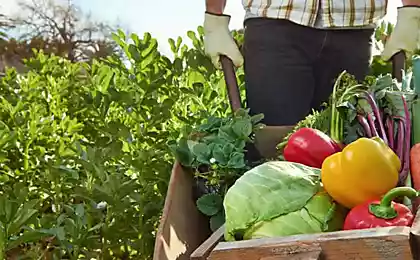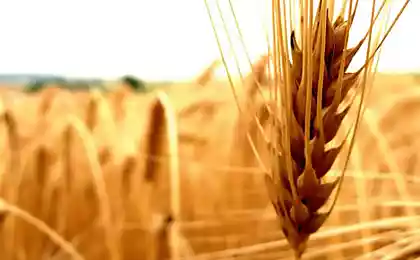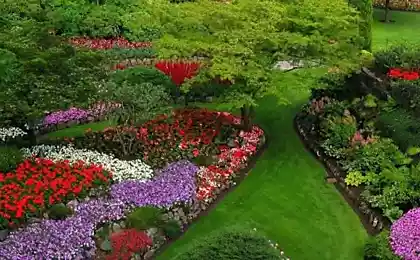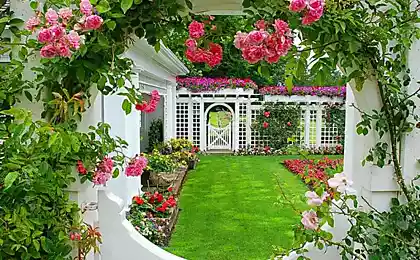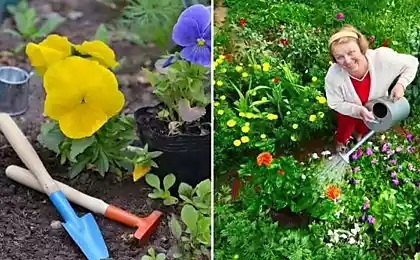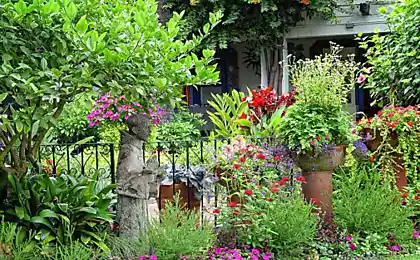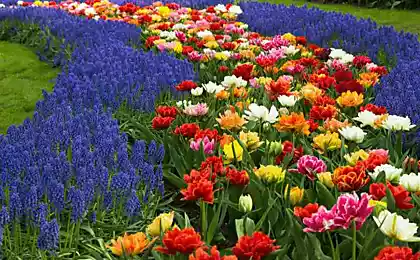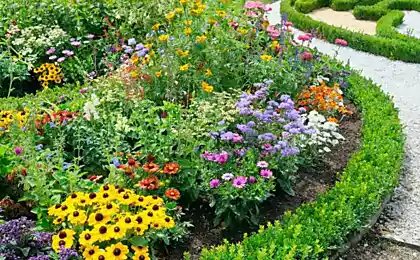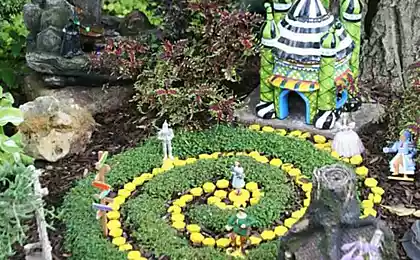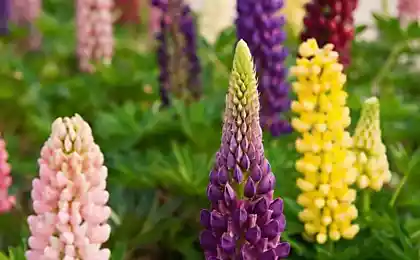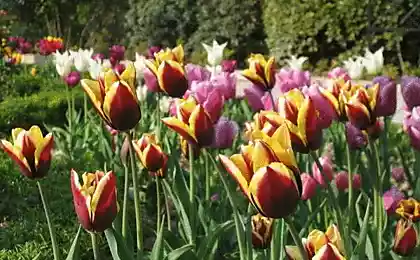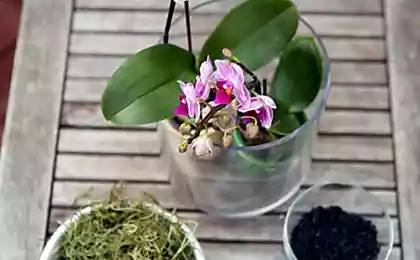398
Classification of flower beds by type and flowering periods
Today it is difficult to imagine life without flowers. But flower beds, as we imagine them, appeared only at the beginning of the XIX century. It was at that time that travelers began to bring beautiful flowering plants to Europe.
Many people mistakenly believe that flower bed and flower bed are the same thing. In fact, a flower garden is a place with ornamental plants grown for decoration. The flower bed is just a kind of flower bed.
Flowers are probably grown in all gardens. But the same types of plants in different people look different. Some of them are planted spontaneously, where there was a place, and others according to a certain plan, so they look stylish. The choice of planting material today is huge. Eyes want a lot, but grabbing everything is unwise. Before buying plants for flower gardens, you need to decide on its style. Regular flower garden style is created by symmetry in plantings and strict proportions. It includes arabesques, flower beds, curbs and slaves.
Landscape style is based on the desire to reproduce wildlife, transitions from one plant species to another smooth, there are no clear boundaries, there is no symmetry. In this style, mixboarders, alpine slides, groups, landscape flower beds, arrays, rockarias are created.
According to the flowering period, flower beds are divided into 4 groups: springs, summer-autumn, automnalia and all-season. They look good in the spring, so they are called. In such flower gardens, the first to reveal scyllas, snowdrops, iridodictiums, crocuses, etc. A little later, hyacinths, tulips, muscari, primrose, daffodils bloom. All bulbs look good in a group landing. In addition to them, two-year-old plants blooming during this period will be appropriate in springarium: forget-me-nots, violas, daisies, etc.
These flowers are beautiful in the same periods of the year. The duration of their attractiveness is achieved due to a certain number of plant species, the flowering period of which varies somewhat. In such flower gardens, usually most of the area is given to perennials, and the free space is filled with pilots.
Autumn flower beds are spectacular until freezing. They are ruled by late-flowering plants: asters, timeless, heleniums, busulnik, solidago, chrysanthemums, etc.
All-season blooms for three quarters of the year, not pleasing the eye only in winter. With warming, halanthus, grooves, crocuses, etc. are shown from the ground. Flowering is picked up by daisies, primrose, viola. Aquilegia, peonies, lupins, irises are in line. Then the pilots will bloom, planted with seedlings. In the summer, lilies, gladiolis, dahlias will please. Autumn will erupt astras, salvia, chrysanthemums, etc.
Flower gardens are divided differently, taking into account the shape and area, planting principles, plant species. A flowerbed is a strict variety of flower garden in a regular style, arranged for the organization of space, and not only for decorative purposes. The shape can be different: round, square, straight and polygonal. The size is not limited, depending on the desires and capabilities of the owners. On the flowerbed, plants varying in height, color and texture are combined in order to obtain a complete composition.
A characteristic feature is an elevated center that allows you to inspect such a flower garden from all sides. Flat options are also allowed, but then taller plants are planted in the central part (pions, aquilegia, dolphiniums, dahlias, etc.). When placing flowerbeds against the wall of the house or fence, the height of the plants should increase to the background. At the edges, a curb of densely planted low-growing plants (hosts, velvets, chisels, sod flox, alissum, etc.) or a border of lawn about 20 cm is desirable. Arabica is a complex form of a large flower garden with an original intricate ornament. We borrowed it from Muslim countries, so the drawing should consist of repetitions and interweavings of the same motifs of saturated tones.
The basis of arabesque is short flowering plants (ageratum, lobelia, fuchsia, begonia, etc.) or soil cover (coleus, stachys, pyrethrum, sedum, echeveria, etc.). When choosing plants, their vital needs should be taken into account, otherwise the stronger will grow and suppress the less adapted, and the arabesque decorativeness will suffer.
Having decided on the shape of arabesque and plants, you need to paint the scheme on paper, and then transfer the ornament to the soil, using cords, pegs and sand and only then start planting. Borders are solid stripes of short plants planted for fringing. Create them to allocate any boundaries (paths, garden areas, etc.). To do this, pillow-shaped or sloshing, necessarily compact plants (hatsania, alissum, vervain, panty eyes, peels, velvets, etc.) close together when growing.
The flower border is made with a width of 10 cm to 40, a height of 20 cm to 35. The curb can have up to 5 rows of plants. The color of the edging should differ from the main flower garden. In wide curbs, it is possible to use evergreen or decorative shrubs that tolerate haircuts well to maintain their shape. In long curbs, a smooth or contrasting transition of one color of flowers into another is allowed.
The mixboarder is an elongated multi-row mixed flower bed. In it, grassy plants are placed in the foreground, and in the background or central - shrubs, low trees. Such landings are harmonious only on a decent area (about 20 square meters).
When creating a mixboarder, first of all, trees are planted (preferably evergreen) and shrubs (samshit, blackberry, lilac, weigela, barberry, etc.). Then herbaceous perennials with a long flowering period (polykolosnik, koreopsis, echinacea, lavatera, etc.). Desirable and plants with interestingly colored foliage (silver wormwood, red-leaved geichers, white-green hosts, etc.), and an unusual form of leaves (irises, astilba, aconites, etc.). The remaining voids are filled with annuals.
More examples of mixboarding can be found on our website in the photo album "Mixboarders"
Alpinarium is an artificially created slide of various stones, in the crevices of which soil is poured and high-mountain plants are planted. For mini-alpinariums, which can be built on homestead plots, suitable hatzania, youth, large-flowered portulac, graceful gypsophyla, marine lobularia, lobelia, etc. These plants tolerate the scorching sun and a temporary lack of moisture.
Rocarium is a flat area with various stones and plants, the space between which is covered with gravel. You can play on the combination of the color of the stones and the color of the pebbles. Rocarius should harmoniously fit into the relief of the site, i.e. streams, the difference in surface heights, the pond should look natural. Any walls of the building or fences located nearby should be masked with shrubs or curly plants. On flat surfaces, stones with sharp edges look foreign, it is better to choose smooth boulders.
The choice of plants is practically unlimited, but it is better to plant such species that will bloom throughout the year, rather than one season. If rakary is supposed to be created in the shade, then you need to select shade-tolerant plants, there will be no sense in sun-loving plants.
An excellent solution for dividing the territory into zones is a vertical flower garden. Pergola, gazebo, arch, entwined with beautiful flowering plants, are able to fence off the recreation area and mask unsightly places. For these purposes, you can use both perennial plants (glycinia, campsis, clematis, etc.), and lianas grown for one season (kobeya, fermenter, etc.). Examples of vertical landscaping can be seen in our photo album
Rabatka is a small rectangular (square) flower bed, arranged most often along the track. By and large, this is the same curb, but consisting of plants of the same species, more often perennial (chrysanthemums, short-sized small-flowered astras, lilies, etc.). Plants in this flower garden are planted in parallel rows or in staggered order.
Today, from the strict rules of workwomen began to move away, more often planted according to the scheme of several species of plants with the same flowering period.
Parter - flower garden ornamental, geometrically correct (rectangular or oval). It is located where it is best seen, i.e. “in the stalls”, usually in front of the house or at the beginning of the garden. A distinctive feature is the isolation from other elements of landscape design, usually lawn.
Of flowering plants, preference is given to low-growing forms that form compact bushes (begonias, balsamins, velvets, etc.). In a small area, it is problematic to create a stall, but you can arrange a garden in the parter plan, i.e. simultaneously plant vegetable crops and flowers.
Solitaire is a single planting of a decorative and leafy, coniferous or flowering plant. Stylish looks on a well-groomed lawn or with mulching of the trunk circle with chips, peat, tree bark. When going to plant a tapeworm, you need to take into account the following: a person standing on the edge of an open area must, without lifting his head, see the whole plant. In other words, the height of the plant in its adult form should refer to the width of the open space as 1: 3. Compliance with this rule in small areas is difficult. Solitaires are more suitable for park landings.
Group - a version of the flower garden, in which plants identical in appearance or variety are grown. Groups are divided into wall, decorating walls or trunk circles of trees, and free growing, broken on the lawn.
Homogeneous groups are created from calendulas, petunia, astilbes, fluxes, pions, etc. For example, from different varieties of cataranthus, which differ in color, a very stylish group in pink-purple-white range is obtained.
Array - continuous planting of flowering plants in a large area. More often used plants of several varieties of the same species, less often - different species. In fact, it is a flowering field, a spectacular sight.
Monoflower is a site planted with plants of the same species, but of different varieties. Roses form rosaries, gladiolus - gladularia, lilies - lilinaries, pions - pionaries. When creating such flower beds, plants that differ in color are planted together or in groups.
The garden is a fenced small plot immediately in front of the house. His task is to be a picture, preferably beautiful. Which one - cold and official or elegant and cheerful - depends on the taste and character of the owner. Its dimensions can be tiny (2 sq.m.) or impressive (can stretch along a thorough fence for many meters).
The garden is planted with flowering plants. A small composition is often built on two dominants, the remaining place is filled with smaller plants. On a large territory, the flight of fantasy is not limited.
Rural flower garden is created from plants growing in this area, no exotic. It is possible to use popular shrubs (samshita, hydrangea, degraded kalina, etc.). The presence of vegetable crops is not prohibited. To attract attention, you can use various wooden utensils (wheels from carts).
This is not quite a flower garden, because in addition to plants there are stumps, tree roots, snags, logs. All the listed materials are processed with protective means for wood, conceived piled, can be woven by knots. In some places, mini-flowers are created. Suitable height branches and stumps can be used as support for weaving plants. You can hang a kashpo with flowers to the snag. There are many options, in this case, it is unlikely to be possible to plan in advance.
rutari
Plant plastic ↑ The most memorable flower garden created on a wire frame, the inner part of which is covered with moss, and filled with a substrate. Plants are selected exclusively carpet, closing with growth, and creating the volume of the conceived three-dimensional figure. The simplest option is a suspended cereal with flowers. More examples of plant plastics you will find in our photo album.
There are many options for flower gardens. It may not be possible to create the first time, but flowering plants are beautiful in any form. Experiment.
Source: 101dizain.ru
